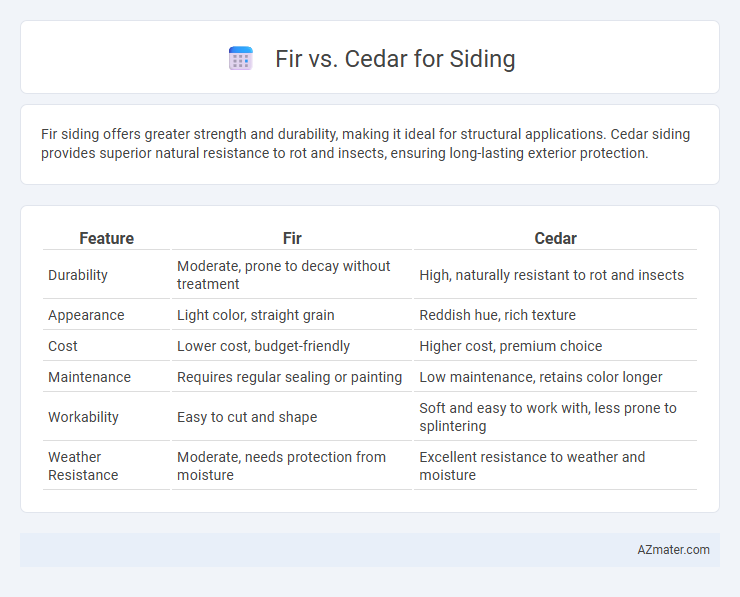Fir siding offers greater strength and durability, making it ideal for structural applications. Cedar siding provides superior natural resistance to rot and insects, ensuring long-lasting exterior protection.
Table of Comparison
| Feature | Fir | Cedar |
|---|---|---|
| Durability | Moderate, prone to decay without treatment | High, naturally resistant to rot and insects |
| Appearance | Light color, straight grain | Reddish hue, rich texture |
| Cost | Lower cost, budget-friendly | Higher cost, premium choice |
| Maintenance | Requires regular sealing or painting | Low maintenance, retains color longer |
| Workability | Easy to cut and shape | Soft and easy to work with, less prone to splintering |
| Weather Resistance | Moderate, needs protection from moisture | Excellent resistance to weather and moisture |
Introduction: Fir vs Cedar for Siding
Fir and cedar are popular wood options for siding, each offering unique aesthetic and durability qualities. Fir is known for its strength and smooth finish, making it ideal for modern designs, while cedar provides natural resistance to rot and insects with a distinct aromatic scent. Selecting between fir and cedar siding depends on factors such as climate, maintenance preferences, and desired appearance.
Appearance and Grain Patterns
Fir siding offers a smooth, even texture with a tight, straight grain pattern that enhances a clean, contemporary look. Cedar siding features a more pronounced, rustic appearance with distinct knots and varying grain patterns, providing a naturally warm and textured aesthetic. Both woods can be stained or finished to highlight their unique grains, but cedar's rich color variations and character marks often appeal to homeowners seeking a traditional or craftsman style.
Durability and Lifespan
Fir siding offers a strong and dense wood structure that provides solid durability but requires regular maintenance to prevent decay and insect damage, typically lasting 20 to 30 years with proper care. Cedar siding is naturally resistant to rot, insects, and moisture due to its high oil content, resulting in a longer lifespan often exceeding 30 years with minimal maintenance. The natural preservatives in cedar make it a preferred choice for longevity and resilience in various climates compared to fir.
Resistance to Weather and Rot
Fir siding offers moderate resistance to weather but is more susceptible to rot compared to cedar due to its softer wood fibers. Cedar possesses natural oils and tight grain structures that provide superior resistance to moisture, decay, and insect damage, making it ideal for harsh weather conditions. The durability and longevity of cedar siding outperform fir when exposed to prolonged wet and humid environments.
Maintenance Requirements
Fir siding requires regular sealing and staining every 2-3 years to protect against moisture and UV damage, making it moderately high-maintenance. Cedar siding offers natural resistance to rot and insects due to its oils, reducing the need for frequent treatments, though it should still be cleaned and resealed every 3-5 years to maintain its appearance. Proper maintenance of both wood types enhances longevity and preserves the wood's natural beauty over time.
Cost Comparison
Fir siding generally costs less per square foot compared to cedar, making it a budget-friendly option for homeowners looking to save on initial installation expenses. Cedar, while more expensive upfront, offers greater durability and natural resistance to rot and insects, potentially reducing long-term maintenance and replacement costs. The overall cost-effectiveness depends on the project's scope, local availability, and desired lifespan of the siding materials.
Environmental Impact
Fir siding is often preferred for its rapid growth rate, which supports sustainable forestry practices by reducing deforestation pressure. Cedar, while naturally resistant to decay and insects, typically requires less chemical treatment, minimizing environmental toxins during its lifecycle. Both woods are renewable resources, but sourcing from responsibly managed forests and considering local availability plays a critical role in reducing the overall environmental impact of siding choices.
Insulation and Energy Efficiency
Fir siding offers moderate insulation properties due to its tight grain structure, providing decent thermal resistance which helps reduce energy costs. Cedar, however, excels in insulation and energy efficiency because of its natural cellular composition that traps air, enhancing thermal performance and maintaining indoor temperature stability. Choosing cedar siding can lead to better energy savings and improved home comfort compared to fir.
Installation Process
Fir siding offers straightforward installation thanks to its consistent grain and ease of nailing, reducing labor time and costs. Cedar, while durable and resistant to decay, requires careful handling during installation to prevent splitting and may need pre-drilling for nails. Both woods benefit from proper moisture barriers and ventilation during installation to ensure long-lasting siding performance.
Choosing the Best Wood for Your Siding
Fir offers exceptional durability and a fine, straight grain that enhances siding appearance, making it ideal for a sleek, modern look. Cedar provides natural resistance to decay and insect damage, with its rich color and distinctive aroma adding warmth and character to exterior walls. Selecting fir or cedar for siding depends on your preference for longevity and aesthetic, as fir delivers strength and smoothness, while cedar ensures natural protection and timeless beauty.

Infographic: Fir vs Cedar for Siding
 azmater.com
azmater.com